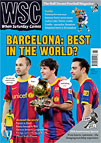 Saul Pope looks at a rising challenge to the traditional elite of Russian football, with plenty of money and some famous faces
Saul Pope looks at a rising challenge to the traditional elite of Russian football, with plenty of money and some famous faces
Since its creation in 1992 Moscow sides have largely dominated the Russian top flight, winning 14 of 19 league titles and taking the lion’s share of second and third places. Lately, this stranglehold has been broken somewhat by Zenit St Petersburg and Rubin Kazan. However, this season two teams from the North Caucasus – the scene of wars and insurgency for much of the last two decades – aim to upstage them all.
Dagestan’s Anzhi Makhachkala and Chechnya’s Terek Grozny finished 11th and 12th respectively last season, both just three points above relegation in a league of 16. However, in the close season both clubs attracted new and wealthy sponsors. Anzhi’s new owner is Suleyman Kerimov, whose investment has given the club an estimated budget of $60 million (£37m) for the new season; while sponsorship from new vice-president Bulat Chagaev at Terek has seen their budget rise to $50m. Another vice-president at the club has boasted that there are “no limits” to future spending as Terek move to become a “super-club”.
So far the money has been used for generating publicity as much as rebuilding the teams. Anzhi’s biggest pre-season signing was 37-year-old Roberto Carlos on a two-and-a-half-year contract worth €9m (£8m). He’s been made club captain and has been ever present so far, though not everyone has been impressed – an opponent in the recent Zenit v Anzhi game described him as having “lost his pace” and being “constantly outplayed”. The club has also spent heavily on two current Brazilian internationals, Jucilei and Diego Tardelli.
Terek’s new manager is Ruud Gullit, better known as a coach for clashing with players than winning trophies. Some local fans have suggested he won’t last a year, about average for foreign managers in Russia. Terek’s president (and also president of Chechnya) Ramzan Kadyrov recently hosted a high-profile exhibition match in Grozny in which he captained a side featuring Gullit and Lothar Matthäus against a Brazil team including Romário, Bebeto and Cafu. A new 30,000-capacity stadium for the city will open in May with another big match. Sport Express recently reported that Juventus were offered €1m to play.
The big names may have come to the Caucasus, but the instability is far from over. It is safe enough to play homes matches there, but both clubs currently train outside the region. Dagestan has seen a recent rise in Islamist radicalism and street violence – there have been several suicide attacks in the last year, including in Makhachkala itself. There is more stability in Chechnya, though fighting with insurgents still takes place. Kadyrov is accused of various human rights abuses and has less than edifying views on women’s rights. When Gullit took the job, he was criticised in the Dutch media for working with a “dictator”; his defence was that he isn’t interested in politics.
Public opinion in Russia has been mixed. One contributor to Championat.ru quoted a Pushkin drama in describing the money spent on Gullit and Carlos as “a feast in time of plague”. Indeed, it is difficult to disagree with those suggesting it would have been better spent on the country’s social sector. Other fans have been more upbeat, focusing on the boost such big names will give the Russian Premier League. There is hope that Carlos in particular will boost flagging attendances and encourage other ageing stars to finish their careers in Russia.
In a region commonly prefixed with “troubled” in the press, it has to be hoped the benefits will be wider than just football. One messageboarder wrote of hopes that the region “will be reborn and flourish, and peace will finally come”. It seems local fans agree. Writing in Sport Express, Igor Rabiner described a unity that is rarely seen in the rest of the country. Terek fans were recently spotted supporting the home side at an Anzhi match and when the Brazilians came to Grozny, fans from Dagestan and Ingushetia came to support their neighbours. Bad language is rare, let alone the racist chants witnessed elsewhere in Russia; chants of “Caucasus!” are instead common.
Though Anzhi have started the better, both sides will settle for steady progress this year. Russian teams have had money lavished on them before, with mixed results. For every Zenit there’s an Asmaral or Dinamo Moscow. Rather than looking to Russia, the best local role model is Shaktar Donetsk. Fifteen years of heavy but steady investment have seen the club grow from a reasonable post-Soviet side to European regulars with a world-class stadium and training facilities. Though, of course, patience is not something football sugar daddies are naturally inclined towards.
From WSC 292 June 2011